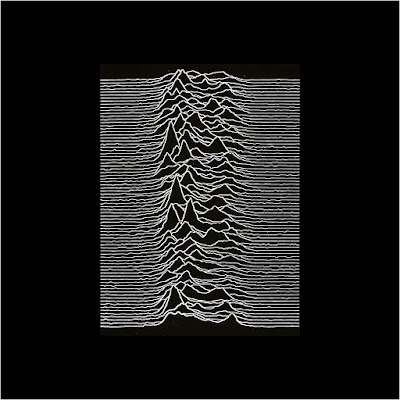Flickr Download DeviantArt
Peter Saville, who had previously designed posters for Manchester's Factory club in 1978, designed the cover of the album. Bernard Sumner chose the image used on the cover, which is based on an image
of radio waves from pulsar CP 1919, from The Cambridge Encyclopaedia of Astronomy. Saville reversed the image from black-on-white to white-on-black and printed it on textured card for the original
version of the album. It is not a Fourier analysis, but rather an image of the intensity of successive radio pulses, as stated in the Cambridge Encyclopaedia. The image was originally created by radio
astronomer Harold Craft at the Arecibo Observatory for his 1970 PhD thesis.
When reviewing the 2007 version of Unknown Pleasures, Pitchfork critic Joshua Klein described the cover art as "iconic". Susie Goldring, reviewing the album for BBC Online said, "The duochrome Peter
Saville cover of this first Joy Division album speaks volumes. Its white on black lines reflect a pulse of power, a surge of bass, and raw angst. If the cover doesn't draw you in, the music will." wikipedia
For my tweak above, I selected the two waves that best resemble the graphs for the human sexual response cycle of a man light blue) and a
woman (pink). CP 1919 is the first discovered radio pulsar. It was discovered at Cambridge in 1967. The term "pulsar" is taken from the words
"pulse" and "quasar". Because it was first thought to resemble an extra-terrestrial beacon, CP 1919 was initially called "little green men" for
the stereotypical portrayal of extraterrestrials as little humanoid-like creatures with green skin and sometimes with antennae on their heads.
woman (pink). CP 1919 is the first discovered radio pulsar. It was discovered at Cambridge in 1967. The term "pulsar" is taken from the words
"pulse" and "quasar". Because it was first thought to resemble an extra-terrestrial beacon, CP 1919 was initially called "little green men" for
the stereotypical portrayal of extraterrestrials as little humanoid-like creatures with green skin and sometimes with antennae on their heads.
The CP 1919 pulsar had a period of 1.3373 seconds and a pulse width of 0.04. This is, of course, too short for thehuman sexual response cycle
(which we commonly couldn't seem to get enough of), but I guess maybe this cycle has some sort of astronomical resemblance.
For loss of words I may call it coital coincidence.
I wouldn't want to think of little green men. This is the original album cover art design.
No. 249, The Virgin All-Time Album Top 1000
No. 8, Music Radar, The 50 Greatest Album Covers of All Time
Reviewing the album for Melody Maker, Jon Savage called Unknown Pleasures an "opaque manifesto" and declared "[leaving] the twentieth
century is difficult; most people prefer to go back and nostalgise, Oh boy. Joy Division at least set a course in the present with contrails for
the future — perhaps you can't ask for much more. Indeed, Unknown Pleasures may very well be one of the best, white, English, debut LPs of
the year."
Retrospective critical writing on the album has been virtually unanimous in its praise. In 1994, Jon Savage described the music as "a definitive
Northern Gothic statement: guilt-ridden, romantic, claustrophobic". Analysing Curtis's work, music journalist Richard Cook remarked in 1983:
"sex has disappeared from these unknown pleasures; it is an aftermath of passion where everything's (perhaps) lost". wikipedia
Album cover art design by Peter Saville, picture of CP 1919 chosen by Bernard Sumner. Album produced by Martin Hannett. Factory, 1979.
(A) Disorder - Day of the Lords - Candidate - Insight - New Dawn Fades
(B) She's Lost Control - Shadowplay - Wilderness - Interzone - I Remember Nothing
"Shadowplay" live from FageOner on YouTube

joydivisionofficial.com
 |
| Previous: Jeff Beck - Beck-Ola |
Back to Gallery 5


































